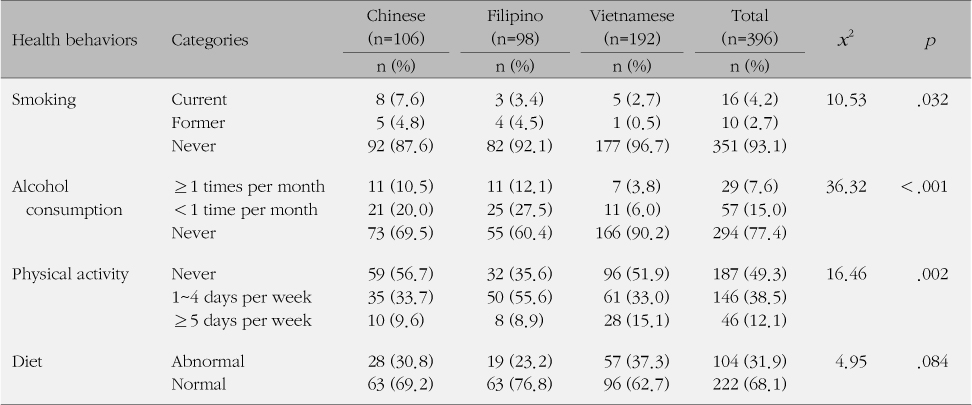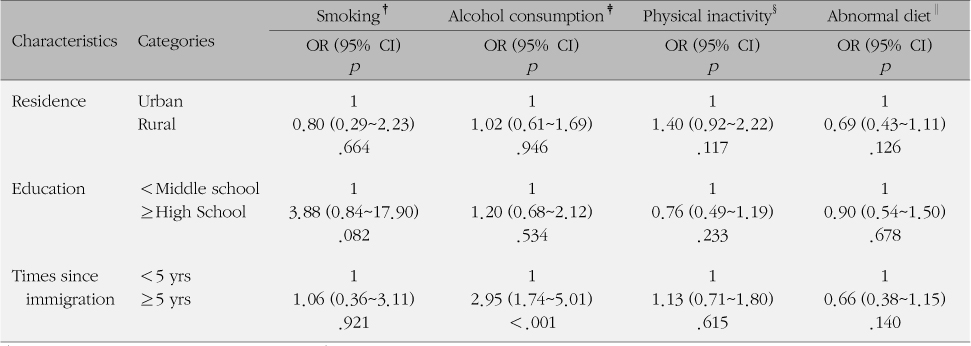Articles
- Page Path
- HOME > J Korean Acad Community Health Nurs > Volume 22(1); 2011 > Article
-
Original Article
- Health Behaviors and Related Factors among Asian Immigrant Women in Korea by Ethnicity
- Sook Ja Yang
-
Journal of Korean Academy of Community Health Nursing 2014;22(1):66-74.
DOI: https://doi.org/10.12799/jkachn.2011.22.1.66
Published online: April 4, 2014
Associate Professor, Division of Nursing Science, College of Health Sciences, Ewha Womans University, Korea.
• Received: February 14, 2011 • Revised: March 21, 2011 • Accepted: March 22, 2011
© 2011 Korean Academy of Community Health Nursing
This is an Open Access article distributed under the terms of the Creative Commons Attribution Non-Commercial License (http://creativecommons.org/licenses/by-nc/3.0/) which permits unrestricted non-commercial use, distribution, and reproduction in any medium, provided the original work is properly cited.
- 666 Views
- 0 Download
- 14 Crossref
Abstract
-
Purpose
- This study aimed to assess the prevalence of smoking, alcohol consumption, physical activity and diet and to identify sociodemographic factors related with health behaviors among Asian immigrant women in Korea by ethnicity.
-
Methods
- A cross-sectional study using structured questionnaires was conducted in 396 immigrant women from China, Vietnam, and the Philippines to Korea through international marriage. The associations between health behaviors and sociodemographic characteristics were assessed using multivariate logistic regression analyses.
-
Results
- The prevalence of current smoking, alcohol consumption, physical inactivity, and abnormal diet were 4.2%, 7.6%, 49.3%, and 31.9%, respectively. The prevalence of current smoking (7.6%) and physical inactivity (56.7%) was highest in Chinese immigrant women. However, the prevalence of current smoking (2.7%) and alcohol consumption (3.8%) were lowest in Vietnamese immigrant women. Immigrant women who had been living in Korea for a long time since immigration (≥ 5 years) had a higher prevalence of alcohol consumption compared to those of who had been living in Korea for a short time since immigration (< 5 years) (OR=2.95, 95% CI=1.74-5.01).
-
Conclusion
- Health promotion programs for immigrant women should be differentiated based on health behaviors and their related factors by ethnicity.
-
The research reported in this article was supported by a grant from the Health Promotion Fund, Ministry of Health & Welfare, Republic Korea (N0. 09-37).
NOTES
- 1. Ahn YH. Health status and health behavior of immigrant women married to Koreans. J Korean Acad Public Health Nurs. 2008;22(1):18–25.
- 2. Allamani A, Innocenti FB, Innocenti A, Cipriani F, Voller F. Alcohol and tobacco consumption among Albanian immigrants in Florence. Subst Use Misuse. 2009;44:282–300. ArticlePubMed
- 3. Balluz LS, Okoro CA, Nokdad A. Association between selected unhealthy lifestyle factors, body mass index, and chronic health conditions among individuals 50 years of age or older by race/ethnicity. Ethn Dis. 2008;18(4):450–457. PubMed
- 4. Bolen JC, Rhodes L, Powell-Griner EE, Bland SD, Holtzman D. State-specific prevalence of selected health behaviors, by race and ethnicity: Behavioral risk factor surveillance system, 1997. MMWR CDC Surveill Summ. 2000;49(2):1–60.
- 5. Chen J, Ng E, Wilkins R. The health of Canada's immigrants in 1994~1995. Health Rep. 1996;7(4):33–45. 37–50. PubMed
- 6. Dogra S, Meisner BA, Ardern CI. Variation in mode of physical activity by ethnicity and time since immigration: A cross-sectional analysis. Int J Behav Nutr Phys Act. 2010;7:75.ArticlePubMedPMC
- 7. Hyman I, Fenta H, Noh S. Gender and the smoking behaviour of Ethiopian immigrants in Toronto. Chronic Dis Can. 2008;28(4):121–127. ArticlePubMed
- 8. Kim HR, Hwang NM, Jang IS, Yoon KJ, Kang BJ. Status and policy of reproductive health of marital immigrant women in Korea. Seoul: Korea Institute for Health and Social Affairs; 2008.
- 9. Kim MJ, Kim TI, Kwon YJ. A study on health promotion behavior and contraception in married immigrant women. Korean J Women Health Nurs. 2008;14(4):323–332. Article
- 10. Kim ON. Mental health of immigrant women in rural communities: Focusing on acculturative stress and social support. Korean J Fam Welf. 2007;12(3):47–73.
- 11. Kim SH, Kim WY, Lyu JE, Chung HW, Hwang RY. Dietary intakes and eating behaviors of Vietamese female immigrants to Korea through marriage and Korean spouses and correlations of their diets. Korean J Community Nutr. 2009;14(1):22–30.
- 12. Kim SK, Kim YK, Cho AJ, Kim HR, Lee HK, Surl DH. Study on current status of multicultural families. Seoul: Korea Ministry of Health & Welfare, Korea Ministry of Gender Equality & Family, Korea Ministry of Justice, & Korea Institute for Health and Social Affairs; 2010.
- 13. Kim WY, Cho MS, Lee HS. Development and validation of mini dietary assessment index for Koreans. Korean J Nutr. 2003;36(1):83–92.
- 14. Korea Immigration Service. Asian immigrant women's residence status by nationality in Korea 2010;Retrieved January 3, 2011. from http://www.moj.go.kr/HP/TIMM/imm_06/imm_2010_09.jsp
- 15. Korea International Labour Foundation. Labour news:Report on immigrants and labourers 2008;Retrieved January 14, 2011. from http://www.koilaf.org/KFkor_new/korNews/bbs_read_dis.php?board_no=4772&page=3&keyField=&keyWord=&keyCode1=B&keyNation
- 16. Korea Ministry of Health, Welfare and Family Affairs, & Korea Center for Disease Control and Prevention. 2007 Korea national health and nutrition examination survey statistics: The 4th Korea national health and nutrition examination survey. Seoul: Author; 2009.
- 17. Lara M, Gamboa C, Kahramanian MI, Morales LS, Bautista DE. Acculturation and Latino health in the United States: A review of the literature and its sociopolitical context. Annu Rev Public Health. 2005;26:367–397. ArticlePubMedPMC
- 18. Lin LH, Hung CH. Vietnamese women immigrants' life adaptation, social support and depression. J Nurs Res. 2007;15(4):243–254. ArticlePubMed
- 19. McDonald JT, Kennedy S. Insights into the 'healthy immigrant effect': Health status and health service use of immigrants to Canada. Soc Sci Med. 2004;59(8):1613–1627. ArticlePubMed
- 20. Misra R, Patel TG, Davies D, Russo T. Health promotion behaviors of Gujurati Asian Indian immigrants in the United States. J Immigr Health. 2000;2(4):223–230.
- 21. Mohan V. Why are Indians more prone to diabetes? J Assoc Physicians India. 2004;52:468–474.
- 22. Newbold KB, Danforth J. Health status and Canada's immigrant population. Soc Sci Med. 2003;57(10):1981–1995. Article
- 23. Nierkens V, de Vries H, Stronks K. Smoking in immigrants: Do socioeconomic gradients follow the pattern expected from the tobacco epidemic? Tob Control. 2006;15:385–391. Article
- 24. Statistics Korea. International marriage status in Korea 2010;Retrieved January 3, 2011. from http://kostat.go.kr/wnsearch/search.jsp
- 25. Stephen E, Foote K, Hendershot G, Schoenborn C. Health of the foreign-born population. Adv Data. 1994;241:1–12.
- 26. World Health Organization. Tobacco control country profiles 2003;Retrieved January 14, 2011. from http://www.wpro.who.int/internet/resources.ashx/TFI/TCCP2.pdf
- 27. World Health Organization. Global status report on alcohol 2004 2004;Retrieved January 14, 2011. from http://www.who.int/substance_abuse/publications/en/philip pines.pdf
Figure & Data
References
Citations
Citations to this article as recorded by 

- Community-based social service utilization of marriage migrants in Korea: Focusing on differences by women’s country of origin*
Joan P. Yoo, Hyemee Kim, Kwang-Hyun Han
The Social Science Journal.2020; 57(1): 39. CrossRef - The influences of socio‐individual determinants and health information seeking on health‐promoting behaviors among migrant women: A cross‐sectional study
Jung‐ae Ahn, Duckhee Chae
Japan Journal of Nursing Science.2019; 16(4): 481. CrossRef - Health of International Marriage Immigrant Women in South Korea: A Systematic Review
Jeong-Ah Ahn, Tiffany Kim, Eun Ha Roh, Ju-Eun Song
Journal of Immigrant and Minority Health.2018; 20(3): 717. CrossRef - The Role of Social Contact in the Experience of Discrimination: Implications for Subjective Health Among Marriage Migrant Women in South Korea
Yuen Mi Cheon, Grace H. Chung
Asian Social Work and Policy Review.2016; 10(1): 34. CrossRef - Exploring the health of female spouses from multicultural families: Examining the differences by their country of origin
Hyemee Kim
Journal of the Korea Academia-Industrial cooperation Society.2016; 17(3): 252. CrossRef - Japanese Female Marriage Immigrants' Dietary Life and Health-related Characteristics by Level of Dietary Adaptation after Immigration to Korea
kana Asano, Jihyun Yoon, Si-Hyun Ryu
Journal of the East Asian Society of Dietary Life.2015; 25(5): 765. CrossRef - Systematic Review of Quantitative Research related to Maternal Adaptation among Women Immigrants by Marriage in Korea
Ju-Eun Song, Eun Ha Roh, So Mi Park
Korean Journal of Women Health Nursing.2015; 21(1): 55. CrossRef - Factors Affecting Health Status and Health Behaviors of Immigrant Women in Urban and Rural Areas
Jae-Ran Lim, Mi Sook Jung
Journal of the Korea Academia-Industrial cooperation Society.2014; 15(4): 2244. CrossRef - Physical Changes in and Coping with Marriage by Immigrant Women at an Early Stage of Immigration
Hee-Ja Kim, Hyun-Sook Kim, Mi-Yang Jeon, Hyo-Jeong Lee, Eun Young Park
Journal of Korean Biological Nursing Science.2014; 16(3): 201. CrossRef - The Impact of Marriage Migrant Women's Korean Language Ability, Self-esteem, and Acculturative Stress on Their Family Health: Focused on Mediating Effects of Marital Adjustment
Ji Hyun Lee, Su Jin Jin, Hyeon Jeong Ju, Yeon Sil Cho
Journal of Korean Academy of Community Health Nursing.2013; 24(1): 87. CrossRef - Analysis of Factors Affecting Unmet Healthcare Needs of Married Immigrant Women
Su Hee Kim, Chung Yul Lee
Journal of Korean Academy of Nursing.2013; 43(6): 770. CrossRef - Factors Associated with Physical Activity among Chinese Immigrant Women
Sung-Hye Cho, Hyeonkyeong Lee
Journal of Korean Academy of Nursing.2013; 43(6): 760. CrossRef - The Factors Affecting Cultural Competency of Visiting Nurses and Community Health Practitioners
Soon-Ok Yang, Myung Soon Kwon, Seung-Hee Lee
Journal of Korean Academy of Community Health Nursing.2012; 23(3): 286. CrossRef - Married Immigrant Women's Utilization of Health Care and Needs of Health Services
Chunmi Kim, Myung Sook Park, Eun Man Kim
Journal of Korean Academy of Community Health Nursing.2011; 22(3): 333. CrossRef

 KACHN
KACHN



 PubReader
PubReader Cite
Cite

